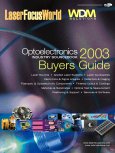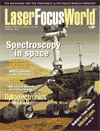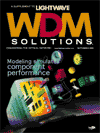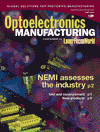 | |||||||||||||
| |||||||||||||

| QUICK VOTE | ||||
|
|
||||
| NEW FROM LASER FOCUS WORLD | ||||
| Webcast Archive: Optical Fiber Solutions presents "Laser Optimized Multimode Fibers" from KMI Research's Newport Conference Dovebid Equipment Auctions Try our new used equipment auctions! Powered by DoveBid 2004 Buyers Guide
Questionnaires |
||||
| PENNWELL CONNECTIONS |
||||
 Fiber-optic communications technology and applications worldwide  The Magazine of Contamination Control Technology  The Magazine for Electronics Assembly |
||||
|
| ||
| SOLID-STATE LASERS: Near-IR and white light result from one crystal | ||
| Paula Noaker | ||
|
The heart of a newly developed superbroadband color-center laser that can generate light over both near-infrared and white-light spectral bands is a single lithium fluoride (LiF:F2+**) crystalline active element. According to Neil Jenkins and Sergey Mirov of the Laser & Photonics Research Center at the University of Alabama at Birmingham (Birmingham, AL), with alexandrite laser pumping, the LiF:F2+** crystal should provide tunability of 800-1300 nm at room temperature. | ||
|
The researchers believe the 500-nm emission spectrum band that they observed from LiF:F2+** is one of the largest for any active medium emitting in the near-IR. Phase-matching this output into standard nonlinear crystals, such as lithium iodide (LiIo3), will provide second-harmonic generation into the visible spectral range (400-650 nm). Collimation of this radiation will make it possible to produce a true white-light laser from one solid-state active medium. | ||
|
Top image is of pumped second-harmonic generation of a
LiF:F2+** superbroadband laser pumped by 1064 nm in a
regime of multifrequency operation. Bottom image is second-harmonic
generation of the laser pumped by 633 nm in a standard
superbroadband regime. | ||
|
According to Jenkins and Mirov, another design goal of the laser was to maintain simultaneous lasing operation in an optically active gain medium at different wavelengths without mode competition. The key to providing this function lies within the unique structure of the laser's external grating cavity. In essence, the superbroadband laser system creates its own microcavities, each lasing at a different wavelength within the fluorescence band of the gain medium. The laser operates in a pulsed mode, and different wavelengths appear at spatially different positions at the output of the laser cavity. | ||
|
Unlike conventional tunable lasers that can switch between different lasing wavelengths within a given wavelength band, the superbroadband laser simultaneously emits at multiple wavelengths. It can thus provide either superbroadband spectral output (a combination of hundreds of independent lasing channels of the laser) or a preassigned multiline spectral composition. | ||
|
Preliminary experiments produced LiF:F2+** superbroadband lasing under 633-nm excitation from the Raman-shifted second harmonic of a Q-switched Nd:YAG laser. The result was ultrabroadband oscillation within an 850-1050-nm spectral range. The output was then phase-matched into a LiIo3 nonlinear crystal for second-harmonic generation into the visible spectral range of 425-525 nm (see photos). | ||
|
Based on spectroscopic analysis, Jenkins and Mirov expect alexandrite laser excitation to produce the full range of superbroadband laser radiation possible with the LiF:F2+** crystal. Realization of this scheme will be a subject of their next publication. They presented the preliminary results on the superbroadband laser at the Advanced Solid State Lasers meeting this month in Davos, Switzerland. | ||
|
Paula M. Noaker | ||
| Laser Focus World February, 2000 | ||
Interested in a subscription to Laser Focus World Magazine? Click here to subscribe! | ||
| BUYERS GUIDE | ||||
 |
||||
| CURRENT ISSUE | ||
   |
||